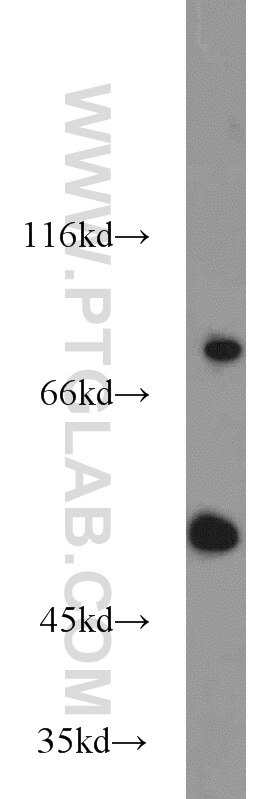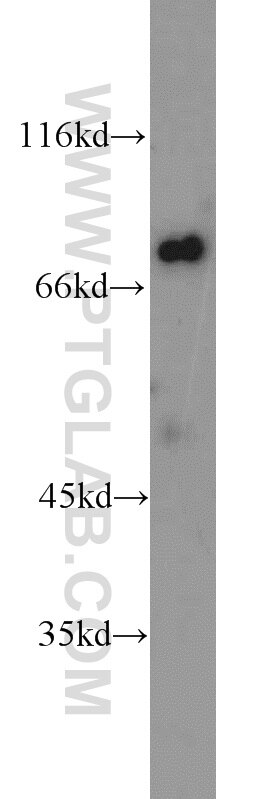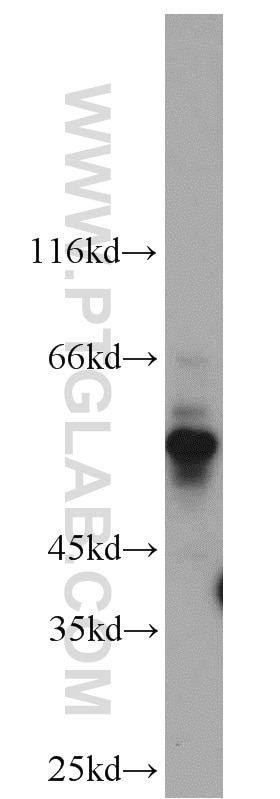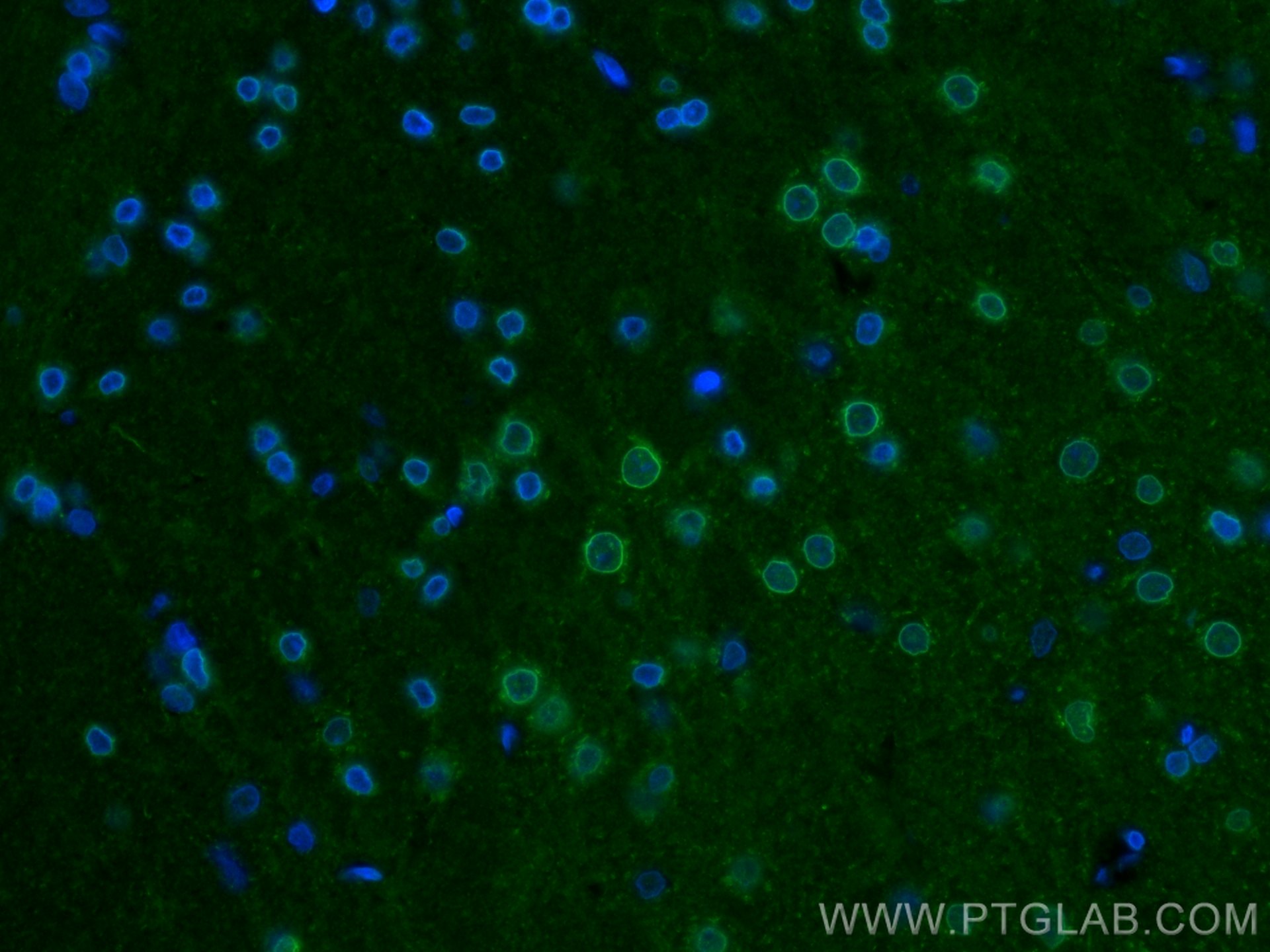- Phare
- Validé par KD/KO
Anticorps Polyclonal de lapin anti-KCNA3
KCNA3 Polyclonal Antibody for WB, IF-P, ELISA
Hôte / Isotype
Lapin / IgG
Réactivité testée
Humain, rat, souris
Applications
WB, IF-P, ELISA
Conjugaison
Non conjugué
N° de cat : 14079-1-AP
Synonymes
Galerie de données de validation
Applications testées
| Résultats positifs en WB | cellules A549, tissu de thymus de souris |
| Résultats positifs en IF-P | tissu cérébral de rat, |
Dilution recommandée
| Application | Dilution |
|---|---|
| Western Blot (WB) | WB : 1:500-1:2000 |
| Immunofluorescence (IF)-P | IF-P : 1:50-1:500 |
| It is recommended that this reagent should be titrated in each testing system to obtain optimal results. | |
| Sample-dependent, check data in validation data gallery | |
Applications publiées
| KD/KO | See 1 publications below |
| WB | See 7 publications below |
| IF | See 5 publications below |
Informations sur le produit
14079-1-AP cible KCNA3 dans les applications de WB, IF-P, ELISA et montre une réactivité avec des échantillons Humain, rat, souris
| Réactivité | Humain, rat, souris |
| Réactivité citée | rat, Humain, souris |
| Hôte / Isotype | Lapin / IgG |
| Clonalité | Polyclonal |
| Type | Anticorps |
| Immunogène | KCNA3 Protéine recombinante Ag5204 |
| Nom complet | potassium voltage-gated channel, shaker-related subfamily, member 3 |
| Masse moléculaire calculée | 575 aa, 64 kDa |
| Poids moléculaire observé | 52 kDa, 75 kDa |
| Numéro d’acquisition GenBank | BC035059 |
| Symbole du gène | KCNA3 |
| Identification du gène (NCBI) | 3738 |
| Conjugaison | Non conjugué |
| Forme | Liquide |
| Méthode de purification | Purification par affinité contre l'antigène |
| Tampon de stockage | PBS with 0.02% sodium azide and 50% glycerol |
| Conditions de stockage | Stocker à -20°C. Stable pendant un an après l'expédition. L'aliquotage n'est pas nécessaire pour le stockage à -20oC Les 20ul contiennent 0,1% de BSA. |
Informations générales
Kv1.3 ( also known as KCNA3, MK3, HGK5, HLK3, PCN3, HPCN3) contains six membrane-spanning domains with a shaker-type repeat in the fourth segment. It belongs to the delayed rectifier class, members of which allow nerve cells to efficiently repolarize following an action potential. It plays an essential role in T cell proliferation and activation. Kv1.3 channels are expressed in in various tissues and cell types including brain, vascular smooth muscle cells and leucocytes. Malfunction of Kv1.3 can alter the immune response, elicit neurotoxic effects or impact on cancer growth(PMID: 24305723; 24133455). 14079-1-AP can detect two isoforms of Kv1.3 other than the canonical channel (60 KDa) : A longer isoform (70 KDa) and a truncated isoform (43 KDa).
Protocole
| Product Specific Protocols | |
|---|---|
| WB protocol for KCNA3 antibody 14079-1-AP | Download protocol |
| IF protocol for KCNA3 antibody 14079-1-AP | Download protocol |
| Standard Protocols | |
|---|---|
| Click here to view our Standard Protocols |
Publications
| Species | Application | Title |
|---|---|---|
Cell Mol Immunol NLRP3-dependent pyroptosis is required for HIV-1 gp120-induced neuropathology.
| ||
Int Immunopharmacol Clarithromycin attenuates airway epithelial-mesenchymal transition in ovalbumin-induced asthmatic mice through modulation of Kv1.3 channels and PI3K/Akt signaling | ||
Int J Clin Exp Med Inhibition of 15-lipoxygenase (15-LOX) reverses hypoxia-induced down-regulation of potassium channels Kv1.5 and Kv2.1Inhibition of 15-lipoxygenase (15-LOX) reverses hypoxia-induced down-regulation of potassium channels Kv1.5 and Kv2.1. | ||
Cell Death Discov Therapeutic potential of voltage-dependent potassium channel subtype 1.3 blockade in alleviating macrophage-related renal inflammation and fibrogenesis | ||
Transl Res Kv1.3 expression on CD4 (+) T cells promotes interleukin-17A-associated airway inflammation and airway remodeling in asthma |





